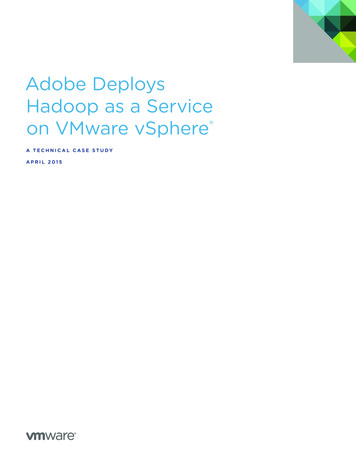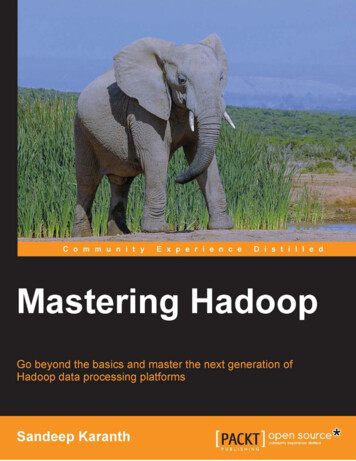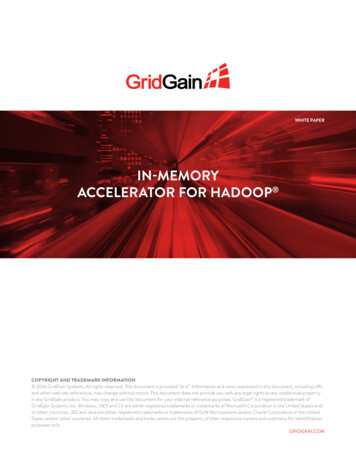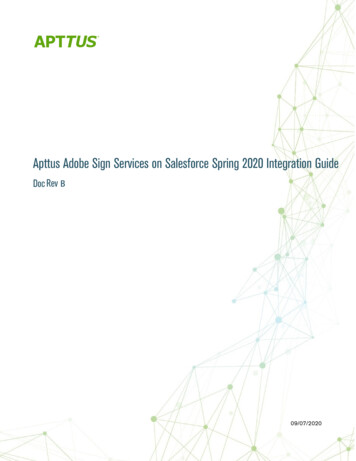
Transcription
Adobe DeploysHadoop as a Serviceon VMware vSphere A TECH N I C AL C A S E STU DYAPRIL 2015
Adobe Deploys Hadoop as a Serviceon VMware vSphereTable of ContentsA Technical Case Study . . . . . . . . . . . . . . . . . . . . . . . . . . . . . . . . . . . . . . . . . . . . . . . . . . . . . . . . . 3Background . . . . . . . . . . . . . . . . . . . . . . . . . . . . . . . . . . . . . . . . . . . . . . . . . . . . . . . . . . . . . . . . . . 3Why Virtualize Hadoop on vSphere?. . . . . . . . . . . . . . . . . . . . . . . . . . . . . . . . . . . . . . . . . . . . 3The Adobe Marketing Cloud and the Digital Marketing Business Unit . . . . . . . . . . . . . . 3The Adobe Virtual Private Cloud: the Platform for Running Hadoop . . . . . . . . . . . . . . . 4Two Hadoop User Communities – Requirements . . . . . . . . . . . . . . . . . . . . . . . . . . . . . . . . . 4The Adobe Hadoop-as-a-Service Portal. . . . . . . . . . . . . . . . . . . . . . . . . . . . . . . . . . . . . . . . . 5Technical Architecture. . . . . . . . . . . . . . . . . . . . . . . . . . . . . . . . . . . . . . . . . . . . . . . . . . . . . . . . . . 7The Hardware Layout. . . . . . . . . . . . . . . . . . . . . . . . . . . . . . . . . . . . . . . . . . . . . . . . . . . . . . . . . . 8Servers and Data Centers . . . . . . . . . . . . . . . . . . . . . . . . . . . . . . . . . . . . . . . . . . . . . . . . . . . 8Configuration of Hadoop Clusters on vSphere. . . . . . . . . . . . . . . . . . . . . . . . . . . . . . . . . 9Monitoring and Management of Hadoop Clusters . . . . . . . . . . . . . . . . . . . . . . . . . . . . . . . 10vRealize Operations Management. . . . . . . . . . . . . . . . . . . . . . . . . . . . . . . . . . . . . . . . . . . 10Important Insights from Virtualizing Hadoop . . . . . . . . . . . . . . . . . . . . . . . . . . . . . . . . . . . 11Future Work. . . . . . . . . . . . . . . . . . . . . . . . . . . . . . . . . . . . . . . . . . . . . . . . . . . . . . . . . . . . . . . . . 11Conclusion . . . . . . . . . . . . . . . . . . . . . . . . . . . . . . . . . . . . . . . . . . . . . . . . . . . . . . . . . . . . . . . . . . . 11Further Reading. . . . . . . . . . . . . . . . . . . . . . . . . . . . . . . . . . . . . . . . . . . . . . . . . . . . . . . . . . . . . . 12TECH N I C AL WH ITE PAPE R / 2
Adobe Deploys Hadoop as a Serviceon VMware vSphereA Technical Case StudyThis case study paper describes the deployment of virtualized Hadoop clusters in production and preproductionuse at the Adobe Digital Marketing Business Unit. It gives a description of the business needs motivating this setof technologies and the use of a portal for providing internal and external users with a Hadoop-as-a-service capability.Adobe has been using tools such as VMware vSphere Big Data Extensions and VMware vRealize Automation (formerly VMware vCloud Automation Center ) for managing virtualized Hadoop clusters since early 2013.BackgroundAdobe is a well-known international software company whose products are used by millions of people worldwide.Adobe’s business is composed of many different parts, one of which is the Adobe Digital Marketing Business Unit,where products and services cover functionality for analytics, campaign management, experience management,media optimization, social networking, and targeting.Adobe has been using Hadoop internally for a set of different applications for several years and has achievedsignificant gains in analytics on its key customer data. The Hadoop ecosystem has been deployed successfullyon VMware vSphere for several different groups of Adobe users within the Digital Marketing Business Unit.Why Virtualize Hadoop on vSphere?Adobe chose to use vSphere as the strategic platform for hosting its Hadoop-based applications for severalreasons: To provide Hadoop clusters as a service to the end users and development community, reducing time to insightinto the data To increase the adoption of Hadoop within the homegrown analytics platform across the company by enablingrapid provisioning of custom clusters To reduce costs by increasing utilization on existing hardware rather than purchasing dedicated servers To avoid the “shadow IT” use of Hadoop by different units in an uncontrolled manner To develop an in-house platform as a service for the developer community to useThe Adobe Marketing Cloud and the Digital Marketing Business UnitIn 2009, Adobe acquired Omniture, which became the foundation of the Adobe Digital Marketing Business Unit.This business unit manages the digital assets of its customers, such as email, social media, and Web presence.One key part of that business is the generation of regular reports for customers on the types of users thatutilize the customers’ Web sites. These regular reports provide details on the end-customer interaction, suchas answers to questions on how much of their Web site usage is repeat business and where the time is beingspent online. This information is generated in reports but is also available online to customers so they canform their own queries against it and draw new business conclusions. One of the main motivations foradopting big data analytics was to extend this capability to put the power into the customers’ hands tointeract intelligently with their own data.TECH N I C AL WH ITE PAPE R / 3
Adobe Deploys Hadoop as a Serviceon VMware vSphereThe Adobe Virtual Private Cloud: the Platform for Running HadoopThe Adobe Digital Marketing Business Unit has created a private cloud infrastructure-as-a-service offering calledthe Adobe Virtual Private Cloud (VPC), which is supported by vSphere technologies. The Adobe VPC is utilizedto various degrees by all of the Adobe Marketing Cloud applications. Adobe currently has five production datacenters worldwide that support the VPC, with expansion plans for three additional data centers by mid 2015.Each of these data centers has a Hadoop platform capability deployed by the Big Data Extensions technologyacross hundreds of servers. The VPC is the foundational layer for all applications and products within thebusiness unit. Adobe did not build a separate infrastructure for the Hadoop clusters; rather, it made use of theservers and foundational software within its VPC for this purpose.Two Hadoop User Communities – RequirementsAdobe separates its use of Hadoop for two diverse groups of people.1. The Engineering Environment (Preproduction)Multiple teams in Adobe engineering wanted to work with various configurations and distributions ofHadoop software for their own purposes. This area conducts new application development, functionalworkload testing, and experimentation with a variety of data stored in Hadoop. Adobe’s forward-thinkingdevelopment of new applications takes place here. Hadoop clusters are provisioned, used for a period oftime, and then can be torn down so that new ones can be created for different purposes. These systemsare not utilized for performance testing. Performance testing is done in a special environment to helpidentify the actual workload after the application has incorporated Hadoop.Some of the preproduction users had not used Hadoop prior to the Hadoop-as-a-service functionality’sbecoming available. Their requirement was to be able to bring up a cluster easily for learning purposes.The preproduction hardware setup matches the production environment for Hadoop at the company.This is done to guarantee that an application under test is experiencing the same conditions as it would inthe production environment and that versions of the various software components are compatible.The perception among the engineering departments was that Technical Operations was not moving fastenough for them in the big data area. They had already gone out to the public cloud providers to get whatthey wanted in terms of MapReduce functionality. This sidestepping of the traditional operations functioneventually produced unwanted side effects such as virtual machine sprawl and higher costs. This occursamong early adopters of Hadoop after the operations team no longer controls the resources. The essentialrequirement was to accelerate the software engineering life cycle for the teams engaged in Hadoop workby provisioning clusters for them more rapidly.Much of the data they need is shared across different Adobe Digital Marketing Business Unit products.The engineers needed answers to two essential questions: Where is my data? How am I going to access that data?There is a separate dedicated environment for performance testing. However, sizing of the environment tosuit a particular Hadoop workload can be done in preproduction. This is a common occurrence with thenewer types of applications and new frameworks, such as YARN. In the preproduction world, users canprovision any vendor’s distribution of Hadoop at any version level they want. There are no limitationsimposed by the operations team. This situation changes when we get to a production environment.TECH N I C AL WH ITE PAPE R / 4
Adobe Deploys Hadoop as a Serviceon VMware vSphere2. The Production EnvironmentIn this environment, the business need was to enable the Marketing Cloud product teams to take advantageof existing data that is managed by Technical Operations. The analytics processing requirement was to beable to process quantities of up to 30Tb of stored data over long periods of time (several years). The purposeof the production Hadoop clusters is to serve both Adobe’s needs and those of its customers who want tobe able to ask questions of their own data that is stored in Adobe’s VPC. The end goal is to provide usersoutside the company with enough tools to enable them to express any query they have. There are somerules applied to the production infrastructure, such as the placement of more limits on the types andversions of the Hadoop distributions that are allowed to be provisioned.Access control to the Hadoop clusters is therefore a prime concern. One Adobe customer should not beable to see or work with another customer’s data. This multitenant requirement made security and isolationof individual virtual machines from each other a high priority for the deployment engineers in AdobeTechnical Operations. As one security measure, only one distribution of Hadoop of a particular versionnumber is allowed to be provisioned in the production environment. Limited numbers of default virtualmachine sizes and configurations were also instituted as an operating principle at the beginning and helpedsimplify the task. Standard – virtual machine (hardware version 10) with four vCPUs and 8GB of RAM. The disk size dependson cluster sizing needs. Large – virtual machine (hardware version 10) with eight vCPUs and 16GB of RAM. The disk size dependson cluster sizing needs.The Adobe Hadoop-as-a-Service PortalAdobe Technical Operations customized the vRealize Automation user interface to conform to the standard ofthe organization, as shown in Figure 1. This illustrates a set of catalog entries that make up the standardconfigurations of Hadoop and other tools that Adobe supplied to its user communities. An end user with suitableentitlements can log in to this portal and provision an entry to get a Hadoop cluster up and running rapidly.The end user is not concerned about the exact hardware configuration that supports the new Hadoop cluster.They know that there is a pool of hardware and storage that supports the cluster and delivers functionality forthe application to use.Figure 1. Top-Level View of the Hadoop Provisioning PortalTECH N I C AL WH ITE PAPE R / 5
Adobe Deploys Hadoop as a Serviceon VMware vSphereFigure 2 illustrates the details of the individual catalog items, indicating the nature of each cluster along withits distribution (Apache, Cloudera CDH, or Pivotal PHD) and version number. The end user is not confined tojust one type of cluster. They can choose to work with different topologies such as compute-only clusters,resizable clusters, and basic clusters and can decide on the correct Hadoop distribution for their needs.Figure 2. Details on the Catalog Items in the Hadoop Provisioning Portal User InterfaceThe portal based on vRealize Automation for managing the Hadoop clusters shown in Figure 2 enables thoseclusters to be started, stopped, and resized by the appropriate users. The “cluster resize” functionalityenables virtual machines to be added to the compute tier of a Hadoop cluster to increase its processingcapacity. Adobe’s engineering staff has customized the workflows that drive these actions, so that onevRealize Automation instance is controlling Hadoop clusters across several VMware vCenter domainsand even across data centers.TECH N I C AL WH ITE PAPE R / 6
Adobe Deploys Hadoop as a Serviceon VMware vSphereTechnical ArchitectureThe high-level technical architecture for the Hadoop cluster provisioning portal solution built by Adobe isshown in Figure 3. Here we see that the vSphere virtualization layer is the base platform for the whole system.When Hadoop is provisioned by the end user, the different roles or daemons in Hadoop become processes thatare running in various virtual machines that vSphere manages. These are the ResourceManager, NodeManager,and ApplicationMaster parts of the Hadoop infrastructure that are mapped into one or more virtual machinesby the Big Data Extensions component in the middle (green) gementBlueprintsSoftware Deployment Life Cycle ManagementvRealize AutomationPlatform as a ServiceBig tratorVMware vCenterOperationsManager vCentervSphereScalable Infrastructure FoundationFigure 3. Outline – Technical Architecture for the Adobe Hadoop Provisioning PortalThe end user does not interact with the Big Data Extensions user interface directly, however. Instead, a separatesoftware layer, shown in orange in the top layer of Figure 3, provides that interaction. The control flow and userinterface or portal is built using the vRealize Automation software. The vRealize Automation runtime engine,augmented with certain workflows that are customized by the Adobe Technical Operations architects, invokesthe Big Data Extensions APIs on the user’s behalf to implement the Hadoop cluster. Big Data Extensions workswith vCenter and enables a vSphere administrator to provision Hadoop clusters onto virtual machines in auser-friendly way. More information on this feature set can be found at http://www.vmware.com/bde.Taking this outline of the architecture down one level to look at some of the details, we see the components inFigure 4. Clients use functionality provided by the vRealize Automation environment, which has a set ofworkflows and blueprints preinstalled in it for interacting with the Big Data Extensions plug-in to vCenter.The Big Data Extensions management server invokes the vCenter APIs to clone a template virtual machine,which is provided inside a vSphere virtual appliance. This virtual appliance is created when Big Data Extensionsis first installed.TECH N I C AL WH ITE PAPE R / 7
Adobe Deploys Hadoop as a Serviceon VMware vSphereThe vRealize Automation component was customized by the Adobe engineers to have the correct look andfeel for the company as well as unique workflows to satisfy the particular Adobe Digital Marketing BusinessUnit requirements. This involved some changes to VMware vCenter Orchestrator workflows that are builtinto the vRealize Automation solution. Likewise, the Big Data Extensions environment was also customized bythe addition of YUM repositories that contain the correct components for installation of a particulardistribution of Hadoop. This is shown in the top-right corner of Figure 4, shaded in light blue. After this setupis in place, users can utilize a Web portal that hides some of the details in Big Data Extensions from them,making the provisioning process simpler for them to use.Node Software, Hadoop DistributionsClientsAdminvRealize AutomationFramework CenterHostHostHostHostvCenter Operations ManagerBig Data Extensions vAppvirtual Provisioning PortalFigure 4. Details – Technical Architecture for the Adobe HadoopdiskThe Hardware LayoutServers and Data CentersAt the time of writing, Adobe has more than 8,000 virtual machines supporting various applications. Thisnumber is growing constantly as more applications are virtualized. Within the big data area alone, the followingdata centers and machines have already been deployed: One preproduction data center–– There are 200 host servers deployed currently.–– There are dozens of small Hadoop clusters running in preproduction at any given time. Five production data centers worldwide–– There are 1,000 host servers deployed currently.–– The number of virtual machines containing Hadoop functionality is continually growing and will be in thethousands as the system is adopted widely over time. Adobe staff are conducting tests with an additional 256 virtual machines at the time of writing.TECH N I C AL WH ITE PAPE R / 8
Adobe Deploys Hadoop as a Serviceon VMware vSphereAll the VPC data centers are backed by a combination of Hitachi SAN and EMC Isilon storage. Hitachi Unified Storage VM – Utilizes tiered storage with Flash for acceleration of performance and transactionrates across the array EMC Isilon X400 nodes – 4U nodes that provide flexible balance between high-performance and large-capacityclustersThe VPC supports 10GbE networking based on Cisco technology. The server hardware comprises theDell PowerEdge M1000e blade enclosure fully populated with Dell PowerEdge M620 blade servers.Each blade server is configured with 256GB of RAM and two Intel Xeon Processor E5-2650 CPUs.Operating system volumes for the various virtual machines are stored on the Hitachi SAN. There is an optionalso for HDFS data storage on an EMC Isilon NAS system. The Isilon storage holds more than 10Pb of data thatit can present to the Hadoop compute tiers using the HDFS protocol.R ute NodeVirtual MachinesVMVMNameNodeHBaseYARNVMCompute NodeVirtual MachinesVMVMDataNodeVMCompute NodeVirtual MachinesHDFS10GbEVMVMVMCompute NodeVirtual MachinesVMVMVMCompute NodeVirtual MachinesVMVMVMCompute NodeVirtual MachinesFigure 5. Technical Architecture for the Hadoop DeploymentConfiguration of Hadoop Clusters on vSphereBig Data Extensions, used by the vRealize Automation tool, places virtual machines that it provisions intoresource pools by default. Two separate resource pools in vSphere can have different shares, limits, andreservations on CPU and RAM, enabling them to operate independently of one another from a performanceperspective while sharing hardware.The innermost resource pools are created along Node Group lines as specified by the user when doing the initialdesign of a virtualized Hadoop cluster. The Master and Worker node groups shown in Figure 6 are located inseparate resource pools, for example. In vSphere, resource pools can be nested within other resource pools.TECH N I C AL WH ITE PAPE R / 9
Adobe Deploys Hadoop as a Serviceon VMware vSphereFigure 6. Configuring the Hadoop Roles Within Virtual Machines for a New ClusterThe outermost resource pool, into which the new Hadoop cluster is placed, is set up by the user before Big DataExtensions provisioning starts. There are eight server hosts in an outermost resource pool by default, but thiscan be changed without affecting the overall architecture. Different resource pools are used in vSphere to isolateworkloads from each other from a visibility and performance perspective.At the VMware ESXi level, there is one Hadoop worker node—that is, one virtual machine containing theNodeManager in Hadoop 2.0—per hardware socket on the server hosts. This is a general best practice fromVMware and supports locality of reference in a NUMA node as well as being a good fit of virtual CPUs ontophysical cores in a socket.Monitoring and Management of Hadoop ClustersvRealize Operations ManagementThe VMware vRealize Operations tool provides Adobe Technical Operations and engineering organizationwith insights into the behavior patterns and performance trends that the Hadoop clusters are exhibiting. Theoperations management tool gathers data to interpret the “normal” behavior of the system over time and canthen identify growing anomalies from that normal behavior to its users. Garbage collection times within theJava virtual machines supporting many of the Hadoop roles are an important measure that Technical Operationspays a lot of attention to. If these times grow at a pace over a period, vRealize Operations points out thesepatterns to the end user, helping to create a more timely solution to an impending problem. The tool is alsoused in the preproduction environment to assess the size of a suitable virtual Hadoop cluster for supportingnew applications.TECH N I C AL WH ITE PAPE R / 1 0
Adobe Deploys Hadoop as a Serviceon VMware vSphereImportant Insights from Virtualizing HadoopThe engineering teams come to Technical Operations for deployment of a new application workload and have aservice-level agreement that they must fulfill. Whereas in the past, the engineering team would have had theadded burden of carrying out capacity management and infrastructure design themselves for the newapplication, now Technical Operations can shorten the time to complete these tasks by providing a temporaryvirtualized environment in which the application can be configured and tested. Ultimately, the business decisionon where best to deploy the application can be made by teams who are not the original application developers.The engineering team might not have had the opportunity to fully test out the applications under load. This isnow done in the preproduction Hadoop cluster previously described. With the help of the vRealize Operationsmanagement tool, the teams can determine the best deployment design for the application as well as whichvirtualized data center it would best fit into.Future Work1. Cloudera Manager – Complementing the vRealize Operations tool, Technical Operations also usesCloudera Manager extensively to view the Hadoop-specific measures that indicate the health of any cluster.Indicators such as HDFS and MapReduce health states enable the operator to see whether or not thesystem needs attention. These measurements are correlated with data from the infrastructure level such asthe consumption of resources by the virtual machines. These complementary views enable one to makedecisions about optimizing workloads on different hosts in a data center.2. The Adobe Digital Marketing Business Unit is investigating using Big Data Extensions to provide data-onlyclusters as described in the joint Scaling the Deployment of Hadoop in a Multitenant Virtualized Infrastructurewhite paper written by Intel, Dell, and VMware.ConclusionProviding Hadoop cluster creation and management on VMware vSphere has optimized the way that big dataapplications are delivered in the Digital Marketing Business Unit at Adobe. The costs of dedicated hardware aswell as management and administration for individual clusters have been greatly reduced by sharing poolsof hardware among different user communities. Developers and preproduction staff can now obtain aHadoop cluster for testing or development without concerning themselves with the underlying hardware.Virtualization has also improved the production Hadoop cluster management environment, enabling moreoperations control over resource consumption and better management of the trade-offs in performance analysis.Virtualizing Hadoop workloads has become an important part of the Adobe Digital Marketing Business Unit,empowering Technical Operations to become a service provider to the business.TECH N I C AL WH ITE PAPE R / 11
Adobe Deploys Hadoop as a Serviceon VMware vSphereFurther Reading1. Adobe Digital Marketing Business Unit Web Sitehttp://www.adobe.com/#marketing-cloud2. VMware vSphere Big Data Extensionshttp://www.vmware.com/bde3. Virtualized Hadoop Performance with VMware vSphere 03604. Virtualized Hadoop Performance with VMware vSphere 6 on High-Performance es/104525. EMC Hadoop Starter Kits Using Big Data Extensions and Isilon H N I C AL WH ITE PAPE R / 12
VMware, Inc. 3401 Hillview Avenue Palo Alto CA 94304 USA Tel 877-486-9273 Fax 650-427-5001 www.vmware.comCopyright 2015 VMware, Inc. All rights reserved. This product is protected by U.S. and international copyright and intellectual property laws. VMware products are covered by one or more patents listedat http://www.vmware.com/go/patents. VMware is a registered trademark or trademark of VMware, Inc. in the United States and/or other jurisdictions. All other marks and names mentioned herein may betrademarks of their respective companies. Item No: VMW-CS-vSPHR-Adobe-Dplys-HAAS-USLET-101Docsource: OIC-FP-1220
The Adobe Digital Marketing Business Unit has created a private cloud infrastructure-as-a-service offering called the Adobe Virtual Private Cloud (VPC), which is supported by vSphere technologies. The Adobe VPC is utilized to various degrees by all of the Adobe Marketing Cloud applications. Adobe currently has five production data










